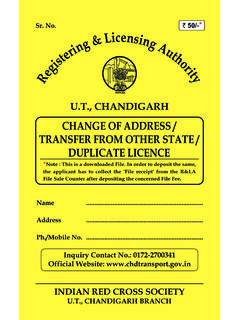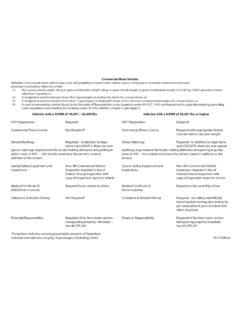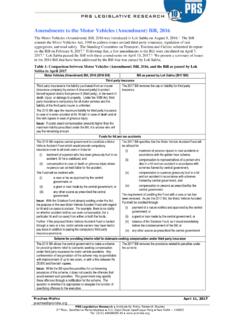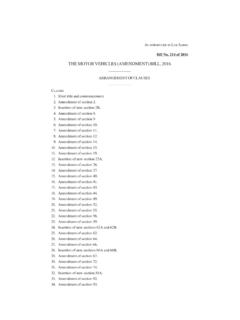Transcription of THE MOTOR VEHICLES ACT, 1988 (59 OF 1988)
1 1 THE MOTOR VEHICLES ACT, 1988 (59 OF 1988 ) (14 Oct. 1988 ) An Act to consolidate and amend the law relating to MOTOR VEHICLES . Be it enacted by parliament in the Thirty-ninth Year of the Republic of India as follows : - Statement of objects and Reasons. - The MOTOR VEHICLES Act, 1939 ( 4 of 1939), consolidates and amends the law relating to MOTOR VEHICLES . This has been amended several times to keep it up to date. The need was, however, felt that this Act should, now inter alia, take into account also changes in the road transport technology, pattern of passenger and freight movements, developments, of the road network in the country and particularly the improved techniques in the MOTOR VEHICLES management.
2 2. Various Committees, like, National Transport Policy Committee, National Police Commission, Road Safety Committee, Low Powered Two Wheelers Committee, as also the Law Commission have gone into different aspects of road transport. They have recommended updating, simplification and rationalization of this law. Several Members of Parliament have also urged for comprehensive review of the MOTOR VEHICLES Act, 1939, to make it relevant to the modern day requirements. 3. A Working Group was, therefore, constituted in January, 1984 to review all the provisions of the MOTOR VEHICLES Act, 1939 and to submit draft proposals for a comprehensive legislation to replace the existing Act.
3 This Working Group took into account the suggestions and recommendations earlier made by various bodies and institutions like Central Institute of Road Transport (CIRT), Automotive Research Association of India (ARAI), and other transport organisations including, the manufacturers and the general public, Besides, obtaining comments of State Governments on the recommendations of the Working Group, these were discussed in a specially convened meeting of Transport Ministers of all States and Union territories. Some of the more important modifications so suggested related for taking care of - 2 (a) the fast increasing number of both commercial VEHICLES and personal VEHICLES in the country ; (b) the need for encouraging adoption of higher technology in automotive sector; (c) the greater flow of passenger and freight with the least impediments so that islands of isolation are not created leading to regional or local imbalances.
4 (d) concern for road safety standards, and pollution-control measures, standards for transportation of hazardous and explosive materials; (e) simplification of procedure and policy liberalization s for private sector operations in the road transport field ; and (f) need for effective ways of tracking down traffic offenders. 4. The Supreme Court in M. K. Kunhimohammed v. P. A. Ahmedkutty (1987) 4 284, has made certain suggestions to raise the limit of compensation payable as a result of MOTOR accidents in respect of death and permanent disablement in the event of there being no proof of fault on the part of the person involved in the accident and also in hit and run MOTOR accidents and to remove certain disparities in the liability of the insurer to pay compensation depending upon the class or type of VEHICLES involved in the accident.
5 The above suggestions made by the Supreme Court have been incorporated in the Bill. 5. The proposed legislation has been prepared in the light of the above background. Some of the more important provisions of the Bill provide for the following matters, namely :- (a) rationalization of certain definitions with additions of certain new definitions of new types of VEHICLES ; (b) stricter procedures relating to grant of driving licences and the period of validity thereof; (c) laying down of standards for the components and parts of MOTOR VEHICLES ; (d) standards for anti-pollution control devices; 3 (e) provision for issuing fitness certificates of VEHICLES also by the authorised testing stations.
6 (f) enabling provision for updating the system of registration marks; (g) liberalised schemes for grant of stage carriage permits on non-nationalised routes, all-India Tourist permits and also national permits for goods carriages; (h) administration of the Solatium Scheme by the General Insurance Corporation; (i) provision for enhanced compensation in cases of no fault liability and in hit and run MOTOR accidents; (j) provision for payment of compensation by the insurer to the extent of actual liability to the victims of MOTOR accidents irrespective of the class of VEHICLES ; (k) maintenance of State registers for driving licences and vehicle registration; (l) constitution of Road Safety Councils.
7 6. The Bill also seeks to provide for more deterrent punishment in the cases of certain offences. 7. The Notes on clauses explain the provisions of the Bill. Amendment Act 54 of 1994 - Statement of Objects and Reasons. - The MOTOR VEHICLES Act, 1988 (59 of 1988 ) consolidated and rationalised various laws regulating road transport. The Act came into force with effect from 1st July, 1989 replacing the MOTOR VEHICLES Act, 1939. 2. After the coming into force of the MOTOR VEHICLES Act, 1988 , Government received a number of representations and suggestions from the state govt.
8 Transport operators and members of public regarding the inconvenience faced by them because of the operation of some of the provisions of the 1988 Act. A Review Committee was, therefore, constituted by the Government in March, 1990 to examine and review the 1988 Act. 3. The recommendations of the Review Committee were forwarded to the State Governments for comments and they generally agree with these 4 recommendations. The Government also considered a large number of representations received, after finalisation of the Report of the Review Committee, from the transport operators and public for making amendments in the Act.
9 The draft of the proposals based on the recommendation of the Review Committee and representations from the public were placed before the Transport Development Council for seeking their views in the matter. The important suggestions made by the Transport Development Council relate to, or are on account of, - (a) The introduction of newer type of VEHICLES and fast increasing number of both commercial and personal VEHICLES in the country. (b) Providing adequate compensation to victims of road accidents without going into longdrawn procedure; (c) Protecting consumers interest in Transport Sector; (d) Concern for road safety standards, transport of hazardous chemicals and pollution control; (e) Delegation of greater powers to State Transport Authorities and rationalising the role of public authorities in certain matters; (f) The simplification of procedures and policy liberalisation in the field of Road Transport; (g) Enchancing penalties for traffic offenders.
10 4. Therefore, the proposed legislation has been prepared in the light of the above background. The Bill inter alia provides for (a) modification and amplification of certain definitions of new type of VEHICLES ; (b) simplification of procedure for grant of driving licences; (c) putting restrictions on the alteration of VEHICLES ; (d) certain exemptions for VEHICLES running on non-polluting fuels; (e) ceilings on individuals or company holdings removed to curb benami holdings; 5 (f) states authorised to appoint one or more State Transport Appellate Tribunals; (g) punitive checks on the use of such components that do not conform to the prescribed standards by manufactures, and also stocking / sale by the traders; (h) increase in the amount of compensation of the victims of hit and run cases; (i) removal of time limit for filling of application by road accident victims for compensation; (j) punishment in case of certain offences is made stringent; (k) a new pre-determined formula for payment of compensation to road accident victims on the basis of age / income, which is more liberal and rational.




![FORM 34 [See Rule 60] Application for making entry …](/cache/preview/6/f/1/5/9/c/2/6/thumb-6f159c26d5f38536dc820b53e96098f9.jpg)




![FORM 9 [See Rule 18(1)] FORM OF APPLICATION …](/cache/preview/6/6/9/d/8/3/e/e/thumb-669d83eeb08e268553e33eab1baf9c9e.jpg)





